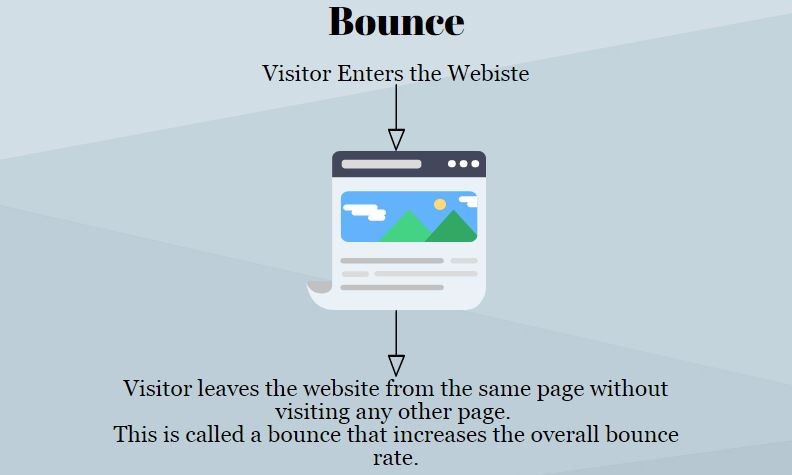What is Bounce Rate? How to Reduce it?

Since the advent of digital marketing, we marketers come across tons of metrics on an everyday basis. Some are simpler to understand while others are confusing. Bounce rate is one of the most essential metrics in digital marketing which is confusing, especially for the newbies. Let us understand bounce rate from both layman’s & geek’s perspective.
What Is Bounce Rate

For a layman, bounce rate is the percentage of people who land on a website, do nothing on the page they entered and leave from that very page. For instance, you are looking for a pair of shoes, and you mistakenly enter a site that deals in refurbished mobiles, you are sure to bounce back. Still confused? Let us try to understand the same with the help of a diagram.
The above explanation is just a gist of what bounce rate means. Furthermore, it is not the only the reason for any website to have a high bounce rate. There are a number of reasons that affect the bounce rate of a site. Here are some of the few factors that increase the bounce rate of a website:
- High page loading time
- Misleading title and description
- A blank page or a technical error
- Low quality or under optimised content
How to Interpret Bounce Rate
Nevertheless, a high bounce rate is not always bad. Yes, you read it right, the good and bad of bounce rate entirely depends on the purpose of the website and its pages. If the primary motive of the page is to provide information, then a high bounce rate is not an issue. Why? Because the users visit the post or page to read or find information and once they get what they were looking for, they leave the website.
On the other hand, if the purpose of the page is to engage with the visitors actively, a high bounce rate becomes a problem. In such cases, the website owner might have to optimise the pages well. This can be achieved either by adding a CTA button (call to action) or having a better UI (user interface).
Traffic sources also impact the bounce rate differently. Let us understand this as well, search traffic is likely to produce a low bounce rate than display & social. The reason for this is simple, inbound channels like organic & paid search will have a low bounce rate. The users are actively searching for what we are promoting via organic & paid channels. We actively capture their attention during the buying journey.
However, this is not the case in display and social channels, where users see the banners on others website, they are hardly interested in the promotion. This, in return, results in a high bounce rate. This is the best possible way to approach or interpret the bounce rate.
How to Reduce Bounce Rate
Thankfully, there are many ways to lower the bounce rate and some of these include:
Effective Internal Linking: Try to interlink your content through relevant key phrases within the post. So, that it gives a reason to the users to stay engaged within the website. This is one of the best practices to reduce the bounce rate.
Compelling Title and Description: Try to have a compelling title and description. Both title and description should match with the copy of the content as they help in keeping the user engaged and eventually reduces the bounce rate.
Decrease the Page Load Time: Nobody likes to wait for more than three seconds for a webpage to load. Therefore, any website with a higher page load time can yield the visitors in the leaving the site. The lower the page load time, the lower the bounce rate.
Add Visual Infographics: Try to add visual infographic to your content, this increases the engagement rate and helps in reducing the bounce rate.
Conclusion
It can be intimidating to analyse and improve the bounce rate; however, an improved bounce rate means more conversions and increased engagement. Follow the steps outlined above, and the bounce rate will start decreasing in no time. Furthermore, for a better understanding, find out the top exit pages and check the page load timings and speed reports to narrow down the actual causes behind the higher bounce rate.
Recent Posts
- Google Search Revolutionized for Educational Videos November 16, 2023
- Bidding Adieu to Google’s Page Experience Report November 9, 2023
- Google November 2023 Core Update November 3, 2023
- Unmasking Google’s October 2023 Spam Update October 5, 2023
- Unleash SEO Power: Must-Have Chrome Extensions for Website Success September 20, 2023
- SEO-Friendly URL Optimization: Mastering Structure for Better Ranking September 20, 2023
- Real Estate Marketing Ideas: Crafting a Results-Driven Marketing Strategy September 20, 2023
- The Anatomy of a Broken Link: Causes, Effects, and Solutions September 15, 2023
- Crafting an Informative FAQ Section: A Step-by-Step Guide September 14, 2023
- Local Business Schema Markup: Elevate Your Brand With The Magic September 14, 2023
Get
in Touch
Contact AdLift for a 360-degree marketing plan
